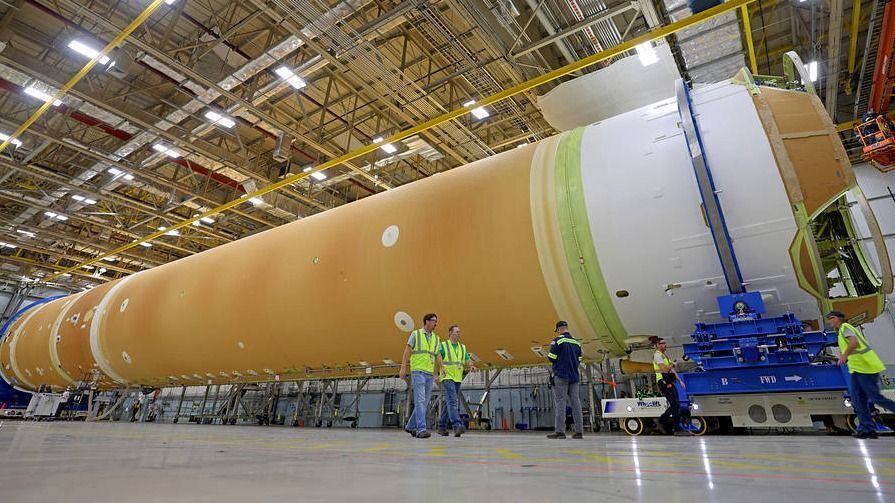Artemis II is the first crewed flight test on the agency’s path to establishing a long-term scientific and human presence on the lunar surface.
NASA and CSA (Canadian Space Agency) will announce during an event at 11 a.m. EDT (10 a.m. CDT) on Monday, April 3, from NASA Johnson Space Center’s Ellington Field in Houston, the four astronauts who will venture around the Moon. Traveling aboard NASA’s Orion spacecraft during Artemis II, the mission is the first crewed flight test on the agency’s path to establishing a long-term scientific and human presence on the lunar surface.
The event will air on NASA Television, the NASA app, and the agency’s website.
Media are invited to attend the event and speak with the astronauts about their assignments. Other experts working on Artemis missions also will be available. Additional opportunities to interview crew remotely will be available on Tuesday, April 4.
International media wishing to attend must contact NASA no later than 5 p.m. CDT Friday, March 17. U.S. media must contact NASA no later than 5 p.m. Monday, March 27. Media can RSVP to the Johnson newsroom by calling 281-483-5111 or emailing: jsccommu@mail.nasa.gov.
Artemis II is the first crewed mission aboard NASA’s foundational human deep space capabilities: the Space Launch System rocket, Orion spacecraft, and the ground systems needed to launch them. The approximately 10-day mission will test and stress the Orion spacecraft’s life-support systems to prove the capabilities and techniques required to live and work in deep space in ways only humans can do.
The crew will include three NASA astronauts and one CSA astronaut, demonstrating the agency’s commitment to international partnerships through the Artemis program. Artemis II builds on the successful Artemis I flight test, which launched an uncrewed Orion, atop the SLS rocket, on a 1.4 million-mile journey beyond the Moon to test systems before astronauts fly aboard the systems on a mission to the Moon.
Quelle:NASA
----
Update: 23.03.2023
.
Artemis 2 moon rocket coming together ahead of 2024 astronaut launch (photo)
The Artemis 2 moon rocket's core stage is nearly fully assembled aside from the engines.

The Space Launch System core stage for the Artemis 2 crewed mission around the moon was assembled on March 17, 2023 and only lacks the engines to complete this tranche of the work. (Image credit: NASA/Michael DeMocker)
NASA just reached a big milestone in moon rocket assembly.
The agency's crewed Artemis 2 mission, which will launch to the moon as soon as 2024, will use a Space Launch System (SLS) rocket core stage that is nearly ready, an update from NASA officials(opens in new tab) indicated on Tuesday (March 21). The core stage is now fully assembled, aside from its four RS-25 engines, which will be popped on shortly.
In less than two weeks, on April 3, NASA will name the three Americans and single Canadian that will fly around the moon for the first crewed mission to Earth's nearest neighbor since Apollo 17 in 1972. Artemis 2 follows on from the successful Artemis 1, which sent an uncrewed Orion capsule to lunar orbit and back late last year.
SLS isn't quite as tall as the 363-foot (111 meter) Saturn V rocket that is most famous for launching six crewed Apollo missions to the lunar surface between 1969 and 1972, along with other missions that orbited or flew around the moon (among other tasks).
But standing at 322 feet (98 m), SLS dwarfs the 184-foot-tall (56 m) space shuttlethat took astronauts to orbit for 30 years, between 1981 and 2011, and the two rockets that take astronauts to the International Space Station today: SpaceX's Falcon 9 (230 feet, or 70 m) and the Russian Soyuz (150 feet, or 46 m).
SpaceX's unflown Starship megarocket stands a shade taller, at around 395 feet (120 m) tall, and will be more powerful, featuring 17 million pounds (7.7 million kilograms) of thrust. But SLS is still quite powerful, generating about 8.8 million pounds (4 million kg) of thrust at liftoff.
SLS is certainly more than strong enough to send four people around the moon and to launch infrastructure toward Earth's nearest neighbor, which is what NASA is counting on.
The larger Artemis program aims to eventually establish a crewed outpost near the lunar south pole. The first astronauts are expected to touch down there in 2025 or thereabouts, on the Artemis 3 mission.
Supporting that work will be NASA's planned Gateway space station, which is how Canada secured its Artemis 2 seat; the Canadarm3 robotic arm will service the orbiting lunar complex in part using artificial intelligence.
Quelle: SC


